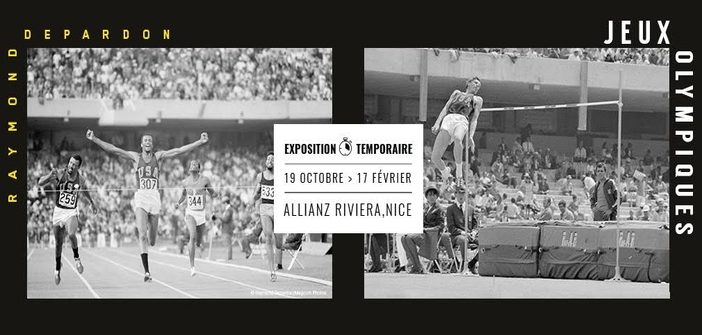The National Museum of Sport in Nice Saint-Isidore is showcasing one of the greatest French photographers, Raymond Depardon.
Comprising 138 black and white photographs, the exhibition “Olympic Games” by Raymond Depardon is presented in a new and original scenography at the National Museum of Sport. It is notably complemented by a mediation offering an analysis of “the photographer’s eye” with the help of archives, sounds, and period equipment, retracing this extraordinary journey of a gifted photographer for whom “sport might be the specialty that best teaches one to truly ‘see’”.
Divided into six zones, the Olympic Games exhibition, spanning nearly 500 m2 of space, chronologically traces the Olympics covered as a photojournalist by Raymond Depardon.
Tokyo 1964
Asia hosts its first Olympic Games. An honor for Japan, which was supposed to organize them in 1940. The memory of the war is still present. The Olympic flame is carried by an athlete born on August 6, 1945, in Hiroshima, recalling the day, year, and place where the American army dropped the first atomic bomb. Japan celebrates sport and presents the world with the image of a country both traditional and modern. It’s a global success backed by the first television broadcasts.
“This first experience was, for me as a young photographer, discovering many things at once, a sort of training session.”
Raymond Depardon, 2012
Grenoble 1968
Forty-four years after the first Winter Olympics in Chamonix, France once again hosts a winter Olympiad. The country is marked by a wave of grandeur and modernity. The political class realizes the importance of these Games. They become an opportunity for significant sports facilities development and ski resort promotion. Joy and pride are in the spotlight. Jean-Claude Killy and Marielle Goitschel capture all the attention: he wins three gold medals, and she triumphs in the slalom.
“The politicians came, de Gaulle inaugurated the Olympic Games, and Mendès-France arrived. (…) In this photo, he wears a curious cap. No Gore-Tex at the time, gray, black anoraks, surely not warm, sad, reminiscent of the post-war period. Nevertheless, everything was fine, just three months before it all exploded.” Raymond Depardon, 2008
Mexico 1968
The era is one of protest. In several countries (France, the United States, Senegal…), students demonstrate. Mexico is affected. Ten days before the start of the Games, a bloody army repression causes hundreds of deaths. And the sport? These are the Games of unprecedented feats. Bob Beamon improves the long jump world record by 55 cm! Dick Fosbury dominates the high jump with his revolutionary technique. Sport becomes a platform for protest and photography, a witness of history.
“These were the most beautiful Games I covered. There was an incredible sense of a permanent celebration, thanks to the Mexican people, but also a pervasive political situation…”
Raymond Depardon, 2012
Munich 1972
The world is in turmoil. On the night of September 5, Palestinian terrorists infiltrate the Olympic village and take Israeli athletes and coaches hostage. The outcome is terrible: the eleven hostages and five of their captors are killed. On the sports side, performances advance: in swimming, Mark Spitz wins seven gold medals, each accompanied by seven world records, and the Soviet Valeri Borzov beats the Americans in the sprint (100 and 200 m). The economics of the Games grows with the introduction of the first official mascot: Waldi the dachshund.
“At nightfall, the commando and the hostages get on a bus…An Israeli athlete turns towards us, I see his face through the viewfinder, he’s far away but I clearly remember his look.” Raymond Depardon, 2004
Montreal 1976
The Romanian gymnast Nadia Comăneci is the queen of the Games, first to achieve the perfect score in seven events. Other athletes also stand out. Guy Drut becomes the first non-American Olympic champion in the 110 m hurdles. Alberto Juantorena achieves the first 400 and 800 m double. Meanwhile, Africa acts. 22 nations boycott the event due to the presence of New Zealand, accused of participating in a rugby match in South Africa, a country of racial segregation.
“I arrive from an eight-month stay in northern Chad for the Françoise Claustre affair, who is still detained. Emaciated, I weigh 58 kg. I’m happy to take my mind off things by photographing sports, which really have nothing to do with the desert.” Raymond Depardon, 2004
Moscow 1990
The tense relations between the two great powers, the United States and the USSR, influence these Games, and the Soviet invasion of Afghanistan leads to a boycott by the Americans and other allied countries. 81 delegations are present in Moscow, the lowest total since 1956. From the sports event, we will remember the performances of the French in fencing and judo, as well as the epic duel between the British Coe and Ovett in the 800 and 1500 m. Ultimately, the Soviets win 195 medals, including 80 gold!
“I also decide to boycott these Games and return to Paris… The Magnum agency, which distributes my photographs, no longer wants black and white photographs; they only want color photographs. Too bad for me, I’m not interested. It’s the end of my Olympic adventure.” Raymond Depardon, 2012
A meditation space is integrated into this exhibition. At the heart of the exhibition, it will allow the analysis of “the photographer’s eye” using objects, anecdotes, archives, and photograph explanations.


